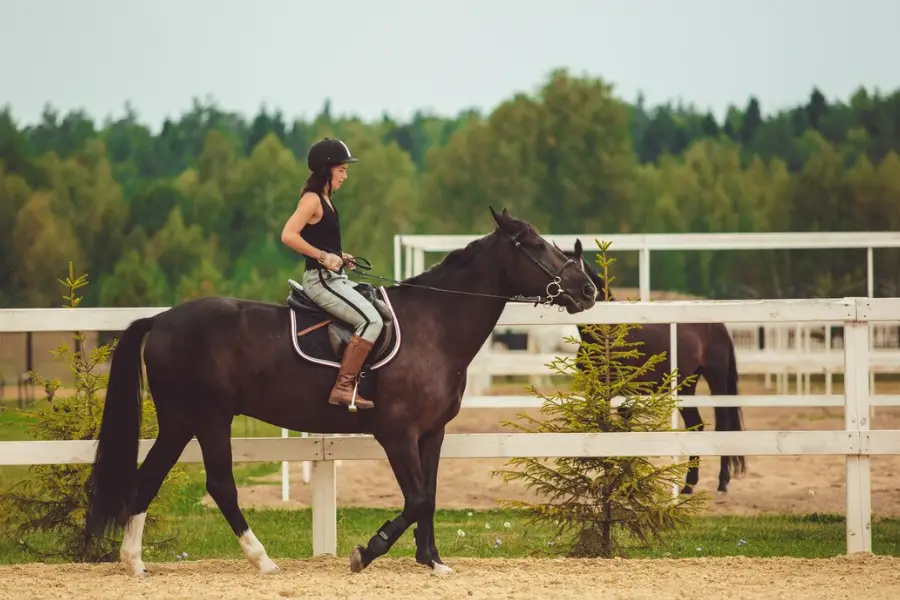How Far Can A Horse Travel In A Day? Answers You Should Care

Are you curious about how far can a horse travel in a day? The fact is that a horse can go so far it might reach 30 to 50km in a day. Some of them only can reach between 15 to 25km. These different results all rely on a horse’s genetic and living conditions. Horse owners can leverage this information to nurture and improve a horse’s physical strength. It will make horses can endure a long time during traveling.
If you are in equestrian activities or simply interested in horse care, this guide can help you optimize your beloved horse’s ability. You need to consider some preparations during a long road. Let’s follow to find the answer.
How Far Can A Horse Travel In A Day?
You might have heard tales of expensive horse breeds covering long distances. An expensive horse like Arabians, Thoroughbreds, and The American Paint Horse can reach up to 100 miles (160 km) within 24 hours. With normal horses, they often travel 25 and 35 miles (40-56 km) a day.
Well-trained horses in peak physical shape may reach the upper end of this range. Most horses are not built to travel long distances continuously without rest. Their endurance can be significantly affected by factors such as the terrain’s quality, the rider’s weight, and weather conditions.
How Far Can A Horse Travel In An Hour A Day

So, how far can a horse travel in an hour during a full day of riding? It is based on the horse’s speed. Another factor is the type of gait used. Some horses can reach speeds up to 40 miles per hour a day (at a gallop).
However, horses often can not maintain this high speed for too long. Typically, they will gallop for short bursts. It covers around 5 to 10 miles in an hour. If a horse is trotting or cantering, they might travel 8 to 15 miles at the same time.
Factors Impacts A Horse’s Travel Distance A Day
The answer “How far can a horse travel in a day” also depends on some factors. They include breed, weight, age, condition, etc. Relative factors are related to how fast can a horse run a day listed below:
- Age: Age impacts the horse’s capacity for long-distance travel. Young horses might not have good endurance. Especially if they are under three years old, they often can not go too far. Elderly horses may not be healthy enough to endure lengthy travels because of diseases.
- Genetics: Different horse breeds also impact long-distance travel. For instance, breeds like the Arabian are known for their endurance. It is an ideal choice for owners for long rides. In contrast, breeds such as Shires may not be as suited for long distances. The reason is that this type of horse is suitable for heavy work.
- Health: Horse owners should be concerned about the horse’s overall health. In case you give proper nutrition, regular veterinary care, and a healthy lifestyle, you need to ensure horses can travel comfortably and effectively. When you have good preparation, your horse will be ensured enough physical strength to come along with you for a long time.
- Conditioning and Training: Horses that are well-exercised and properly conditioned can go further when compared to those who are not.
Horse Gaits Impact On How Far Can A Horse Travel In A Day

Besides physical strength, different gaits also impact the ability of horses during journeys. Let’s follow some keys when each gait affects travel distance:
Walk
The speed of a horse can reach 2 to 4 miles per hour (3.2 to 6.4 km/h) when walking. A horse can cover 24.5 miles (39.2 km) in 7 hours at a steady pace of 3.5 miles per hour.
Beginners should have a horse a walk for the first long journey. Walking is one of the slowest gaits that newbies can control easily. When a horse walks, its legs follow a precise sequence: the right hind leg moves first, then the right front leg, followed by the left hind leg, and the cycle completes with the right front leg.
Trot
When trotting, horses travel faster at about 8 to 12 miles per hour (12.8 to 19.2 km/h). This gait is suggested for experienced people. A rider must perfect the skill of the rising trot. The reason is that the gate requires the ability to synchronize controlled upward and downward movements. Trot is ideal for a long journey for any rider.
Canter
The canter ranges from 10 to 17 miles per hour (16 to 27.2 km/h). This faster pace helps horses cover more ground quickly.
Gallop
Galloping is the fastest gait. It reaches speeds of 25 to 30 miles per hour (30 to 48 km/h). Although horses can gallop quickly, they can’t maintain this speed for long periods. Additionally, the rider has to maintain a half-seat position to minimize pressure on the horse’s back as much as possible. You need to consider carefully choosing the gair for a long road.
Horse Breeds With Great Endurance for Traveling
Certain horse breeds are renowned for their exceptional endurance, making them ideal for long-distance travel. Here’s a look at some of the most notable breeds known for their travel endurance:
Arabian Horses
Arabian horses have good endurance. They were bred in harsh desert environments, which has given them incredible stamina and resilience.
Percherons
Although often used for heavy work, Percherons also possess notable endurance. These draft horses can travel long distances, especially when they are well-conditioned. Their strength and stamina make them reliable for extended travel as well.
Tennessee Walking Horses
Tennessee horse has a unique ambling gait. Walking flat-footed occurs at speeds between 4 and 8 miles per hour. They allow riders to travel comfortably on a long journey.
Morgans
This horse is versatile and hardy with good endurance. They are known for their stamina and strength. It makes them reliable for long rides. Morgans have been used in various disciplines. For example, horse owners will choose them for long-distance riding competitions.
Mustangs
The Mustang horse is a typical example of endurance during traveling. Mustangs evolved in the rugged terrain of the American West. They are famous for developing excellent stamina.
Preparations for a Long-Distance Ride: Equipment and Tack

Horses need to be well-equipped before a journey
You need to ensure your equipment and tack when you decide to participate in a long journey. You will never know if your horse is injured or if you have trouble during a long-distance ride. Here are some suggestions for preparations to assist you.
Inspect the Saddle
You need to make sure the saddle fits your horse correctly. Check for any signs of wear or damage and address them before your ride.
Check All Tack
Next, horse owners need to examine every piece of tack, including bridles, reins, and girths. You need to look for fraying, rust, or any loose stitching. If not, it could lead to failures during your ride. Adjust straps and buckles to ensure they fit well and won’t irritate your horse.
Pack a first-aid kit
You need to equip yourself with a well-stocked first aid kit. This preparation is for both you and your horse. You should bring essentials such as a hoof pick, a multi-tool for quick repairs, and waterproof protection. Do not forget to consider packing spare tack components, such as a bridle, reins, and a billet strap. It helps you to deal with any unforeseen issues.
Horse’s Diet For A Long Road
With a long-distance ride, you need to ensure your horse’s diet. Do not forget to follow a vet-recommended nutrition plan for your horse. You also need to keep your horse well-hydrated and carry enough water for both of you. You can adjust your horse’s feed with high-energy snacks, breads, and hay cubes. These foods are based on the ride’s demands. orse’s feed with high-energy snacks, breads, and hay cubes. These foods are based on the ride’s demands.
FAQs
The fastest time for a horse to complete a 100-mile endurance race is approximately 24 hours. Mustangs are known for their ability to sustain speeds of 35 to 50 mph (56.5 to 80.5 km/h). Their endurance and adaptability support them to finish the 100-mile distance within this impressive timeframe. It includes the bad weather conditions.
The Mongol Derby is a remarkable equestrian endurance race. It covers an impressive distance of 1,000 kilometers, which is the longest horseback ride ever (620 miles).
Horses can generally go a mere 48 hours without water within a few days. It depends on factors like weather conditions, their activity level, and their overall health. However, horse owners need to provide enough water for horses. When you concern yourself with essentials to maintain a horse’s health, your horse can go further.
Final Thoughts
The response to “How far can a horse travel in a day” relies on many factors. These elements include the horse’s breed, fitness level, and the terrain. Generally, horses can cover between 20 to 30 miles (32 to 48 km) in a day under optimal conditions. Some of the warmblood horse breeds like Arabians can exceed this range. Riders and horse owners should consider these variables and prepare appropriately. In this way, it ensures a more successful and enjoyable long-distance ride.



